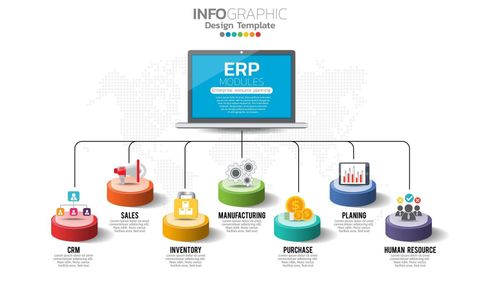Explore the Basics of ERP: A Complete Guide to Enterprise Resource Planning Systems
Enterprise Resource Planning (ERP) refers to an integrated software system that helps organizations manage their core business processes — including finance, human resources, manufacturing, supply chain, and customer relations — all within a unified platform. ERP systems exist to simplify and centralize operations that were once managed through separate tools or manual processes.
Before ERP software, companies often faced challenges with fragmented information, duplicated data, and inefficient workflows. ERP systems emerged as a solution to unify these functions, allowing businesses to make data-driven decisions in real time.
Modern ERP platforms operate on the cloud, enabling access from anywhere and improving collaboration across departments and even international locations.

Importance
ERP systems are vital in today’s global business environment for several reasons. They serve as the backbone of many organizations by connecting data and processes into a single system.
Key reasons ERP matters today include:
-
Efficiency and Automation: ERP reduces manual tasks by automating business workflows such as payroll, procurement, and inventory management.
-
Data Accuracy: Centralized databases eliminate duplicate entries and errors, ensuring that teams work with reliable information.
-
Scalability: ERP systems grow with the organization, supporting expansion and diversification.
-
Decision-Making Support: Real-time analytics help leaders make informed choices quickly.
-
Regulatory Compliance: ERP platforms often include tools for tracking and reporting compliance with laws and industry standards.
ERP affects organizations across all sectors — from manufacturing and retail to healthcare and education — providing a consistent way to manage resources, reduce waste, and improve overall performance.
Recent Updates
Between 2024 and 2025, ERP systems have evolved significantly with new technologies and strategies reshaping how organizations use them. Some of the most notable trends include:
-
AI and Machine Learning Integration (2025): ERP systems now use artificial intelligence to forecast demand, optimize inventory, and enhance financial planning.
-
Cloud-Based ERP Growth (2024–2025): Most modern ERP deployments are now cloud-based, offering flexibility and cost efficiency compared to traditional on-premise systems.
-
Sustainability Tracking (2025): New ERP modules monitor environmental impact, energy use, and carbon footprint to support corporate sustainability goals.
-
Enhanced Data Security (2024): As data breaches rise, ERP vendors have strengthened encryption and access controls.
-
Industry-Specific Solutions: ERP systems are increasingly tailored to niche sectors, including healthcare, logistics, and agriculture.
A recent industry report from early 2025 shows that global ERP adoption has risen by nearly 15% compared to 2023, driven by digital transformation initiatives and remote work strategies.
Laws or Policies
ERP systems are deeply influenced by national and international data protection and compliance regulations. These policies guide how businesses store, process, and share information across departments and borders.
Some key frameworks affecting ERP implementation include:
-
General Data Protection Regulation (GDPR): In the European Union, GDPR governs how companies handle personal data, requiring ERP systems to ensure user consent, transparency, and data security.
-
Sarbanes-Oxley Act (SOX): In the United States, ERP platforms used by publicly traded companies must comply with SOX standards for financial reporting accuracy and internal controls.
-
International Financial Reporting Standards (IFRS): ERP systems must align with accounting and reporting rules for global consistency.
-
Data Localization Laws: Some countries require data to be stored within national borders, influencing cloud ERP hosting decisions.
-
Cybersecurity Frameworks: Governments worldwide are strengthening digital infrastructure policies to secure enterprise software from cyber threats.
These laws ensure that ERP systems operate transparently, protect user privacy, and maintain data integrity, helping organizations remain compliant and accountable.
Tools and Resources
A variety of tools, platforms, and resources can help organizations and individuals better understand, implement, or optimize ERP systems.
-
ERP Software Platforms: Widely used systems include SAP S/4HANA, Oracle ERP Cloud, Microsoft Dynamics 365, and NetSuite.
-
Data Visualization Tools: Applications like Power BI or Tableau integrate with ERP systems for advanced reporting and analytics.
-
ERP Implementation Checklists: Available on professional platforms and consulting websites to guide deployment steps.
-
Online Learning Resources: Courses on Coursera, edX, and LinkedIn Learning provide ERP fundamentals and system-specific training.
-
Industry Reports: Publications from Gartner, Deloitte, and IDC offer insights on ERP trends and performance benchmarks.
-
Integration Tools: Middleware platforms like MuleSoft or Dell Boomi help connect ERP systems with CRM, HR, or e-commerce applications.
Example Table: Comparison of Cloud vs On-Premise ERP Systems
| Feature | Cloud ERP | On-Premise ERP |
|---|---|---|
| Accessibility | Anywhere, via the Internet | Limited to internal network |
| Maintenance | Managed by vendor | Managed by internal IT team |
| Initial Setup | Quick deployment | Longer installation process |
| Scalability | Easily scalable | Requires manual upgrades |
| Security Responsibility | Shared with provider | Fully managed by organization |
FAQs
What does ERP stand for, and what does it do?
ERP stands for Enterprise Resource Planning. It is a system that integrates various business processes into a single platform, allowing departments to share information and improve overall efficiency.
Is ERP suitable only for large companies?
No. While ERP systems were originally designed for large enterprises, modern cloud-based ERP solutions are now accessible to small and medium-sized organizations as well.
How does ERP improve business performance?
ERP enhances performance by automating repetitive tasks, reducing data errors, improving collaboration, and providing real-time insights for better decision-making.
What challenges can arise during ERP implementation?
Common challenges include data migration issues, staff training needs, and system customization complexities. Proper planning and phased implementation help reduce these risks.
How secure are ERP systems today?
Modern ERP platforms use encryption, multi-factor authentication, and access control to ensure high levels of security, protecting both business and customer data.
Example Graph: Key Benefits of ERP Implementation (2025 Survey Results)
| Benefit | Percentage of Organizations Reporting Improvement |
|---|---|
| Data Accuracy and Access | 45% |
| Process Efficiency | 30% |
| Decision-Making Speed | 15% |
| Regulatory Compliance | 10% |
Conclusion
Enterprise Resource Planning systems are essential for managing the complexity of modern business operations. By bringing together finance, HR, manufacturing, and supply chain management into a single ecosystem, ERP ensures consistency, accuracy, and strategic growth.
As technology evolves, ERP systems are becoming smarter, more sustainable, and easier to use. Integrations with AI, IoT, and cloud computing make them central to digital transformation efforts across industries.





